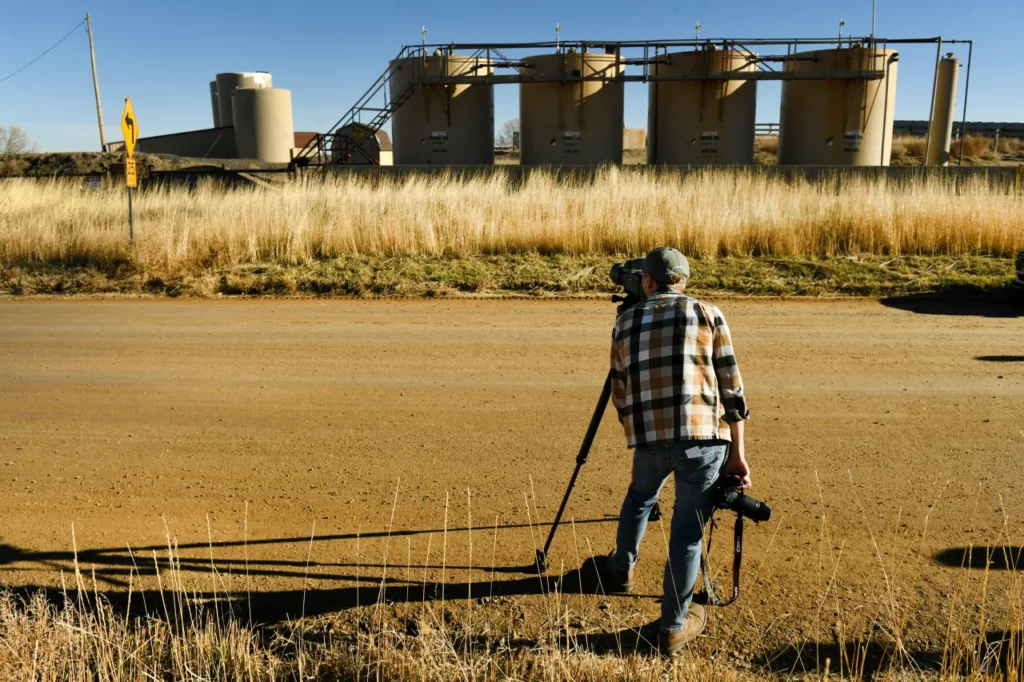Testimony delivered for public comment hearing on proposed rules to reduce oil and gas methane by the U.S. Environmental Protection Agency, January, 2023.

My name is Andrew Klooster, I live in Denver, Colorado, and I am a certified optical gas imaging thermographer and the Colorado Field Advocate with the environmental nonprofit Earthworks.
I want to start by thanking you for offering this opportunity for the public to weigh in on the supplemental proposal and for all of your work in building on the 2021 draft rule over the last year. In particular, I want to express support for the improvements made to the LDAR standards that will hopefully result in routine inspections at more wells regardless of production levels.
In my role with Earthworks, I have documented dozens of pollution events using our optical gas imaging cameras at low producing well sites, inactive well sites, and abandoned well sites in just the last year alone. The EPA however must ensure in adopting and then working with states to implement these rules that these standards for more frequent monitoring of leak and malfunction prone equipment are actually adhered to, especially because so many smaller facilities have escaped oversight from regulators for so long.
I also want to express my support for the concept of a Super Emitter Response Program but believe it must be broadened to be more inclusive of data and evidence that could help supplement regulatory oversight of the oil and gas industry. State regulatory agencies do not have the capacity to effectively monitor this industry. In Colorado, the Air Pollution Control Division inspects roughly 2000 facilities with air permits annually at present. There are over 10,000 oil and gas facilities in our state with air permits. Even if the Division staff focused solely on oil and gas inspections they would still need approximately 5 years at their current inspection rate to inspect each facility only once.
Last year, I conducted over 550 surveys of oil and gas facilities with our OGI camera in Colorado. I recorded 135 videos highlighting pollution events that I suspected could be evidence of noncompliance with air quality standards and submitted those to the Division. A significant number of these pollution events were ultimately determined to not represent actionable compliance issues either because sources were calculated to be below air pollution thresholds or because I had captured emissions from a temporary source that was not regulated or because an operator claimed that the site was undergoing maintenance or upset conditions at the time of my recording. Even with all of these sometimes questionable omissions and exceptions, a third of my videos did indicate possible noncompliance and in 7 out of 10 of those instances operators also identified issues that required repairs or other interventions. Most of the time, the operators were unaware of any issue prior to having received my video from Division staff. Of those 135 pollution events I recorded, the Division sent staff to investigate on six occasions. Six out of 135.
I share all of this to demonstrate the efficacy of our OGI surveys in identifying compliance issues that neither state agencies or operators themselves are aware of. Focusing the Super Emitter Response Program solely on quantifiable thresholds means excluding third party evidence such as OGI that can clearly demonstrate compliance issues. It also means excluding evidence of possible shortcomings or gaps in regulatory oversight of certain pollution events, such as the significant pollution we continue to observe from temporary sources on sites that are actively drilling and fracking.
In Colorado, many operators claim to employ best management practices to reduce the impacts of pre production and yet the Division had to recently publicly admit that they had made mathematical errors in calculating emissions from the industry and that drilling and fracking emissions in fact outweigh all vehicle emissions in the Front Range in contributing to our severe nonattainment in ozone standards. Meanwhile, we have documented OGI evidence of pollution from pre production activities, despite best management practices being in place, that made this recent revelation unsurprising to say the least.
The oil and gas industry has operated for decades without any regard for the impacts their activities have had on the climate and on public health. Accountability is long overdue and one way the EPA can start – START – to account for generations of harm, given the reality of limited regulatory capacity, is by adopting rules that are broadly inclusive of valuable third party evidence.
